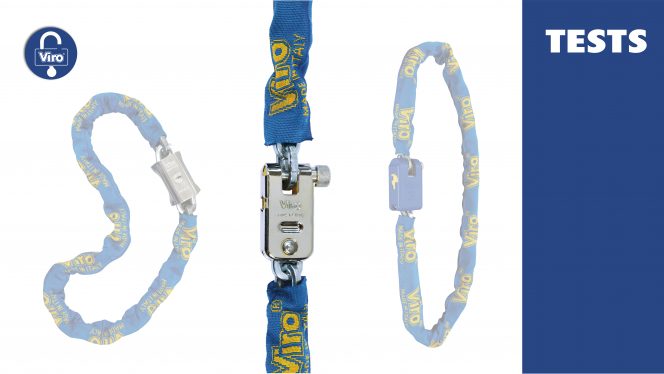In the last article, after outlining the characteristics of the 3 resistance tests to which the security items are subjected (if you have any doubts about it please have a look at this link), we focused on the results of these tests on Viro padlocks and compared them to the imported items.
As promised, today we are going to see how some Viro padlocks with chain react to these same tests compared to imitation products which are available on the market.
It is worth remembering, as can be seen from the pictures below from the 1984 catalogue (and 1994 for the Supermorso), that it was in fact Viro which designed and launched on the market, over 35 years ago, the armoured padlocks (called “Morso”, “Supermorso” and “Bloccacatena”) specifically for use with chains, as they are longitudinal to them; all those in commerce of similar shape, with other brands, are therefore imitations.
TESTS ON PADLOCKS WITH CHAIN
- “MORSO” AND “SUPERMORSO” WITH VIRO CHAINS
“Morso” with chain vs. Imitation: impact resistance test
Let’s suppose that a thief wants to steal a bike: first he will have to free it from the chain which protects it and which anchors it to a fixing point, and one of the ways he will have to do it will be to strike the joint between the padlock rod and the chain with violent blows. During this test, we test the two items with 5 strokes (if they don’t break first) with a 3.05 kg sledgehammer. Find out how they react!
Resistance Test during Hitting – Viro Morso’s COPY (body in zamak):
Resistance Test during Hitting – Viro Morso
While the Copy breaks after only 3 shots, letting the rod that frees the chain come out, the original Viro (whose body is in solid brass, protected by a case-hardened and tempered steel armor) after 5 shots, only loses its head of the rod in the point foreseen for the “programmed break”. In this case, therefore, the chain remains anchored to the rod and the padlock remains closed.
“Morso” and “Supermorso” with chain vs. Imitation: result of salt spray tests
After 40 hours of salt spray (which is equal to about 10 months of outdoor exposure to continuous harsh weather conditions) these are the results!
“Supermorso” with chain vs. Imitation: testing resistance to cutting and being struck by blows
And here are the reactions of both products to the last two tests!
- “BLOCCA CATENA” WITH VIRO CHAIN (8 mm)
“Blocca catena” con catena vs Imitazione: test in nebbia salina
“Blocca catena” with chain vs Imitation: salt spray test
The two products were subjected to a 40-hour salt spray test, which is equivalent to about a year’s life in an environment exposed to extreme climatic conditions.
Salt Spray Test – “Blocca catena” and copy:
Find out how and why the two chains react in this way!
“Blocca catena” with chain vs. Imitation: cutting resistance test
In these short videos we verify the resistance to cutting of the two products, which have already been tested in the previous salt spray test.
Cutting Resistance Test – Blocca Catena’s COPY:
Cutting Resistance Test – Viro Blocca Catena
The test results:
What characteristics do these results imply? Find out here!
“Blocca catena” with chain vs. Imitation: impact resistance test
The last test of the series foresees 5 blows from a height of 1 metre with a strong 3.05 kg hammer. In this blog the videos and images show by how much and how the two products are able to withstand violent attacks
Do you want to know 3 strong points of chains which (maybe) you didn’t know? You can discover them now by clicking here!



